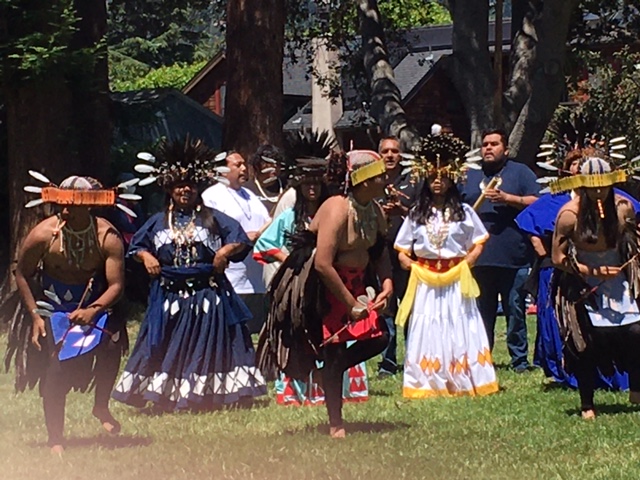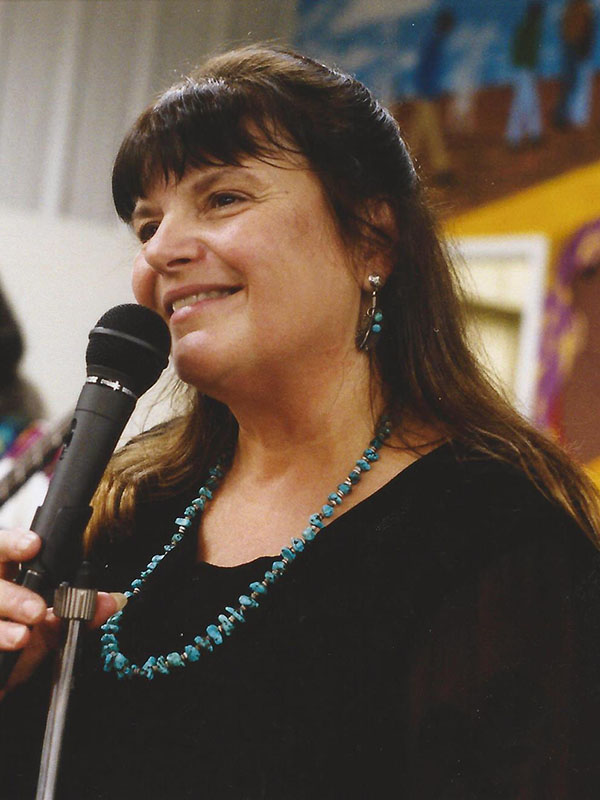
- Details
- By Nanette Deetz
BERKELEY, Ca.–Sometimes a special event comes together after years and years of planning and sometimes it happens overnight due to the “magic of the moment”. Such was the inspiration for the 3rd Annual California Indian Arts and Culture Festival or “California Native Ways,'' held on June 11, 2022 in Berkeley’s Ohlone Park. The festival brought together 20 artists, culture bearers, story tellers, dancers, and singers from around the state, who maintain and expand the artistic heritage of Native California. In addition to demonstrations of traditional arts and crafts, two traditional canoes were displayed, one carved from a redwood log by George Blake of the Hupa and Yurok Nations and one plank canoe carved by artist L. Frank Manriquez of the Tongva/Acjachemen Nation. Both artists answered questions from those attending.
A special performance by the acclaimed Elem Pomo dance group led by Robert Geary from Clearlake was a highlight of the day's activities. Robert Geary is one of the Elem Indian community’s ceremonial roundhouse leaders. His dance group performed a traditional mfom Xe or “people dance.” This dance was introduced to the people as a way of protecting them from the destruction brought about in the post-contact period by settlers to the people and the land. It was the only dance where young and old alike danced together. The mfom Xe combined the power and medicine of the young with that of the old, in order to create a power that would ensure their peoples existence. This was a time when so many were dying due to genocide, disease, and other social, and family disruptions and displacement throughout northern California.
The event was curated by Northern Sierra Mewuk basket weaver Jennifer Bates, founding board chair of the California Indian Basketweavers Association. “With all that is going on around us today, what a great event it will be for Berkeley to again support the native first peoples of California to share their cultures from the many parts of the state”, said Bates. “It can remind us all that we once lived off the land that surrounds us and that we thrived on making and doing with the foods and tools that Mother Earth has given us. Today, more than ever people need to see, learn, and teach their children how important the old ways are”.
Produced jointly by Jennifer Bates, and California Institute of Community, Art and Nature’s (California I CAN), Associate Director Claire Greensfelder, the 3rd Annual festival, over 1,000 people attended over the course of a day that began with a Welcome Ceremony presented by representatives of different Ohlone tribal groups from northern California. Corrina Gould, (Lisjan Ohlone) Executive Director of Sogorea Te Foundation and Save the West Berkeley Shellmound offered a prayer for all in attendance. “I am honored to be here with everyone in attendance. I pray to Creator, and ancestors, Grandmothers and Grandfathers. We thank you and ask for the protection of our waterways, our salmon, our song bearers, to bless us with fresh water for the next 7 generations and beyond. We ask for prayers for Mother Earth, for the healing of her body, our waterways, seas, rivers, bays and fog…We thank you for the beauty of our lives.” Gregg Castro (Ramaytush Ohlone, T’rowt’raashi Salinen, and Rumsen) who sits on the Advisory Board for California I CAN reminded everyone that “We call this an art exhibit and it is, but it is so much more. This represents us as a people; to us, these exhibits are our heart, our soul, our spirit. This is who we are, and represents thousands of years of our family and tribal knowledge that we are willing to share with you, in the hopes that it will enrich your lives as it has ours. I am so very grateful to Malcolm Margolin for all he has done for California’s Indian Tribal Nations”.
Noted basket weavers who participated included Lucy Parker (Yosemite and Coast Miwuk/Mono Lake Paiute/Kashaya Pomo) and her family; Linda Yamane (Rumsen Ohlone); Dixie Rogers (Karuk/Modoc); Kimberly Stevenot (Northern Sierra Mewuk); Carson Bates (Northern Sierra Miwuk) hemp cordage maker; Cherlku Blake (Hupa) baby cradle maker; Anthony Steele (Pomo)clamshell bead maker; Lois Connor-Bohna (Mono/Chuckhansi) demonstrated acorn processing as well as exhibiting her baskets. In addition to those artist demonstrators, ten artists exhibited and sold their creations. Artists were Nancy Napolitan (Coast Miwuk/Pomo) watercolor graphics; Vivian Snyder (Yurok) clay dolls, jewelry), Stephanie Ferris (Dry Creek/Pomo) jewelry and beadwork; Johnny Clay (Pomo/Maidu) graphics;JoAnn Dennys (Essalen) jewelry; Kathleen Smith (Coast Miwuk/Pomo) graphics; Eva Ellingson (Walker River Paiute/Mono/Washoe) jewelry; Monique Sonoquie (Tongva/Chumash/Yaqui/Zapotec/Irish) Mixed media and seaweed baskets; QuarterPint Partido (Pomo) abalone jewelry.
Malcolm Margolin, 81, executive director of California I CAN, set up a spot under the shade of local Oak trees, surveyed the landscape while watching the Elem Pomo dancers, and marveled and truly appreciated the beauty of the event. “Jennifer Bates has done an amazing job of assembling some of the best traditional and contemporary artists in northern California,” said Margolin, who is the author of the landmark book about California Indian history, culture, and lifeways, The Ohlone Way; Indian life in the San Francisco-Monterrey Bay Area and the founder and former publisher of HeyDay Books. He also publishes the magazine, News from Native California, now celebrating its 35th year. “These are people whose memories dip into another time and place, some of whom grew up in a world that is so different from our world today. This Festival is about what it means to be human.”
More Stories Like This
Watermark Art Center to Host “Minwaajimowinan — Good Stories” ExhibitionMuseums Alaska Awards More Than $200,000 to 12 Cultural Organizations Statewide
Zuni Youth Enrichment Project Takes Top Emerging Artist Apprentices to Phoenix for Artistic Exploration and Cultural Immersion
From Dishwasher to Award-Winning Chef: Laguna Pueblo's Josh Aragon Serves Up Albuquerque's Best Green Chile Stew
Rob Reiner's Final Work as Producer Appears to Address MMIP Crisis
Help us defend tribal sovereignty.
At Native News Online, our mission is rooted in telling the stories that strengthen sovereignty and uplift Indigenous voices — not just at year’s end, but every single day.
Because of your generosity last year, we were able to keep our reporters on the ground in tribal communities, at national gatherings and in the halls of Congress — covering the issues that matter most to Indian Country: sovereignty, culture, education, health and economic opportunity.
That support sustained us through a tough year in 2025. Now, as we look to the year ahead, we need your help right now to ensure warrior journalism remains strong — reporting that defends tribal sovereignty, amplifies Native truth, and holds power accountable.
 The stakes couldn't be higher. Your support keeps Native voices heard, Native stories told and Native sovereignty defended.
The stakes couldn't be higher. Your support keeps Native voices heard, Native stories told and Native sovereignty defended.
Stand with Warrior Journalism today.
Levi Rickert (Potawatomi), Editor & Publisher

